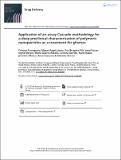Por favor, use este identificador para citar o enlazar a este item:
http://hdl.handle.net/10261/176804COMPARTIR / EXPORTAR:
 SHARE SHARE
 CORE
BASE CORE
BASE
|
|
| Visualizar otros formatos: MARC | Dublin Core | RDF | ORE | MODS | METS | DIDL | DATACITE | |

| Título: | Application of an assay Cascade methodology for a deep preclinical characterization of polymeric nanoparticles as a treatment for gliomas |
Autor: | Fornaguera, Cristina CSIC ORCID; Garrido, Cristina CSIC; Borrós, Salvador | Palabras clave: | Glioblastoma multiforme Nanoparticle preclinical characterization NCL assay cascade protocol Polymeric nanoparticles Paclitaxel Research lab results translation |
Fecha de publicación: | 7-feb-2018 | Editor: | Taylor & Francis | Citación: | Drug Delivery 25 (1): 472-483 (2018) | Resumen: | Glioblastoma multiforme (GBM) is the most devastating primary brain tumor due to its infiltrating and diffuse growth characteristics, a situation compounded by the lack of effective treatments. Currently, many efforts are being devoted to find novel formulations to treat this disease, specifically in the nanomedicine field. However, due to the lack of comprehensive characterization that leads to insufficient data on reproducibility, only a reduced number of nanomedicines have reached clinical phases. In this context, the aim of the present study was to use a cascade of assays that evaluate from physical-chemical and structural properties to biological characteristics, both in vitro and in vivo, and also to check the performance of nanoparticles for glioma therapy. An amphiphilic block copolymer, composed of polyester and poly(ethylene glycol; PEG) blocks, has been synthesized. Using a mixture of this copolymer and a polymer containing an active targeting moiety to the Blood Brain Barrier (BBB; Seq12 peptide), biocompatible and biodegradable polymeric nanoparticles have been prepared and extensively characterized. In vitro studies demonstrated that nanoparticles are safe for normal cells but cytotoxic for cancer cells. In vivo studies in mice demonstrated the ability of the Seq12 peptide to cross the BBB. Finally, in vivo efficacy studies using a human tumor model in SCID mice resulted in a significant 50% life-span increase, as compared with non-treated animals. Altogether, this assay cascade provided extensive pre-clinical characterization of our polymeric nanoparticles, now ready for clinical evaluation. © 2017 The Author(s). | Versión del editor: | https://doi.org/10.1080/10717544.2018.1436099 | URI: | http://hdl.handle.net/10261/176804 | DOI: | 10.1080/10717544.2018.1436099 |
| Aparece en las colecciones: | (IQAC) Artículos |
Ficheros en este ítem:
| Fichero | Descripción | Tamaño | Formato | |
|---|---|---|---|---|
| Application of an assay Cascade methodology for a deep preclinical characterization of polymeric nanoparticles as a treatment for gliomas.pdf | 2,46 MB | Adobe PDF |  Visualizar/Abrir |
CORE Recommender
PubMed Central
Citations
3
checked on 24-abr-2024
SCOPUSTM
Citations
8
checked on 24-abr-2024
WEB OF SCIENCETM
Citations
7
checked on 28-feb-2024
Page view(s)
181
checked on 23-abr-2024
Download(s)
223
checked on 23-abr-2024
Google ScholarTM
Check
Altmetric
Altmetric
Artículos relacionados:
NOTA: Los ítems de Digital.CSIC están protegidos por copyright, con todos los derechos reservados, a menos que se indique lo contrario.
